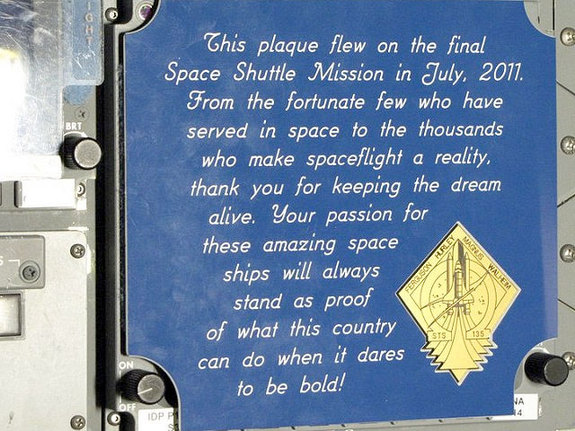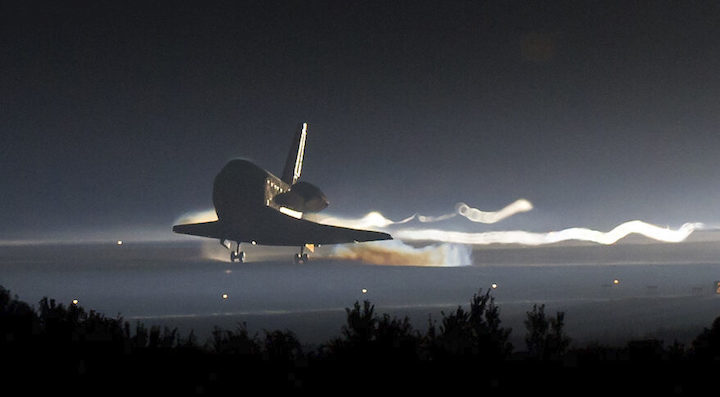26.07.2011
Manchmal sind wenige Worte mehr als ein ganzes Buch, so auch die Worte auf der Plakette an Atlantis von der letzten Crew bevor es ins Museum geht. Bildquelle: NASA

Quelle: NASA
----
Update: 7.08.2021
.
Op-ed | The Last Shuttle Flight — A 10-Year Lesson

In looking back at the month of July, space milestones and events took center stage. Not only did July see the most important American accomplishment in space – the Apollo XI landing on the Moon on July 20th, 1969 – but it also saw the successful launch of two private industry human spaceflight operations
The first was the July 11 suborbital spaceflight of the Virgin Galactic VSS Unity spaceplane, with Richard Branson and five other crew members. The second was the July 20 flight of the rocket-powered New Shepard spacecraft developed by Jeff Bezos’ company Blue Origin LLC carrying Bezos, his brother, Mary Wallace “Wally” Funk of the 1960s Mercury 13 “Women in Space” program and one paying passenger (his payment went to charity).
But this July commemorated another historically important, albeit somewhat bittersweet, space event as well — it was the 10 year anniversary of the last U.S. Space Shuttle flight. On July 8, 2011, NASA launched STS-135, which took the shuttle Atlantis and her crew of four veteran astronauts — Commander Chris Ferguson, Pilot Doug Hurley, and Mission Specialists Sandy Magnus and Rex Walheim — on a routine trip to the International Space Station — or as routine as any Shuttle flight could be. It was the 37th flight to dock at the space station, with the primary objective being to deliver supplies and spare parts to the International Space Station. After several days in orbit, Atlantis successfully returned to Earth on July 21, touching down at Kennedy Space Center for the last time.
STS-135 was the final tour of duty in what was NASA’s 30 year shuttle program, which performed a wide range of unique and groundbreaking missions for the U.S. space program from 1981 to 2011. Over those three decades — which also saw the tragic Columbia and Challenger disasters — the shuttle kept Americans moving up into space and allowed us to secure new gains in scientific advancement, exploration and understanding. At the same time, the shuttle program served as an immense point of national pride and interest — not only did legions of Americans tune in regularly to watch shuttle launches, but in the context of larger geopolitical events, the shuttle program stood as a highly visible reminder of America’s space leadership, technological acumen, and adventurous spirit. In fact, over the course of the shuttle program’s lifetime, America’s dominance in space was virtually unmatched.
But that all ended with Atlantis’ last run in midsummer a decade ago. And in the 10 years since that last mission, we have learned — and perhaps relearned — some painful lessons regarding space. On one level, after STS-135, we would be completely without an American-owned and operated human spaceflight system. After the retirement of the shuttle, the Russian Soyuz served as the only mode of human space transport to reach the International Space Station — literally leaving American astronauts, their safety, and our role in space at the hands of the Russians. This gap endured until the first flight of SpaceX’s Crew Dragon Demo 2 in May of 2020. And while we are now, thankfully, moving seriously forward on reestablishing our own serious space transport system, having to seek favor from Russia seems compromising at best and lacks dignity at worst.
At the same time and on a more strategic level, the fact that the U.S. — which had led the world in space for generations — now had to rely on Russia for space access smacked as a real step backward. Maintaining and operating a successful, reliable and safe space program that can transport human beings beyond Earth’s atmosphere is the insignia of modern, leading world powers. Conversely, not being able to make that claim, even if only temporarily, gives adversaries a talking point. This is a lesson our pacing competitors — particularly China — understand and take very seriously.
And on a final level, terminating the shuttle program without a coherent, funded plan regarding a ready backup had the effect of further delaying and dragging out the process for a replacement. In the intervening years, efforts to establish U.S. human spaceflight options for reliable and ready access to space have been costly, disruptive and elusive, with several presidential administrations and congresses differing on approach and underfunding NASA and its programs. One could argue that without space-focused billionaires, we still wouldn’t be there.
Of course, the reasons for retiring the shuttle seemed to make sense to many policymakers at the time. The expense of the program was deemed too significant and some of the initial visions of the program were never met. And, safety concerns loomed large after the Challenger disaster, and even more so following the loss of Columbia. But the criticism of killing the shuttle program from some corners was notable.
In fact, at the time, Apollo 11 astronaut Neil Armstrong commented in testimony before Congressthat, “We will have no American access to, and return from, low Earth orbit and the International Space Station for an unpredictable length of time in the future”…”For a country that has invested so much for so long to achieve a leadership position in space exploration and exploitation, this condition is viewed by many as lamentably embarrassing and unacceptable.”
Fast forward to the present, we are seeing what that half-generation gap in capability has brought. Fortunately, American efforts to get back to space on our terms, with our own technology look promising — particularly with the private sector taking a significant lead to make American-driven human spaceflight a reality. But if the period after STS-135 is any reminder, a broad spectrum of complications, crises, funding concerns, or global distractions, could significantly challenge our ability to stay on track to reestablish and advance a human spaceflight program — remember, even the private sector is reliant on NASA-paid demand. Congress’s decision in late 2020 to cut funding for the Human Landing System is a perfect recent example.
So this year, as we marvel at the recent notable strides made by the private sector in moving humans back into space — and which may help usher in a new era of interest in space and space travel — we also need to reflect on what the last 10 years since STS-135 have meant. We also need to remember that last flight of Atlantis and what it represented — as well as what the entire U.S. Space Shuttle program achieved and meant for our nation. In looking 10 years back on the last mission of July 2011, and at the lack of an American spaceflight option after STS-135, we need to learn our lesson. With peer competitors deadly serious about their roles and ambitions in space, it would serve us well to not leave any gaps for our adversaries to exploit — whether to Earth orbit, to the moon or even to Mars.
Quelle: SN

